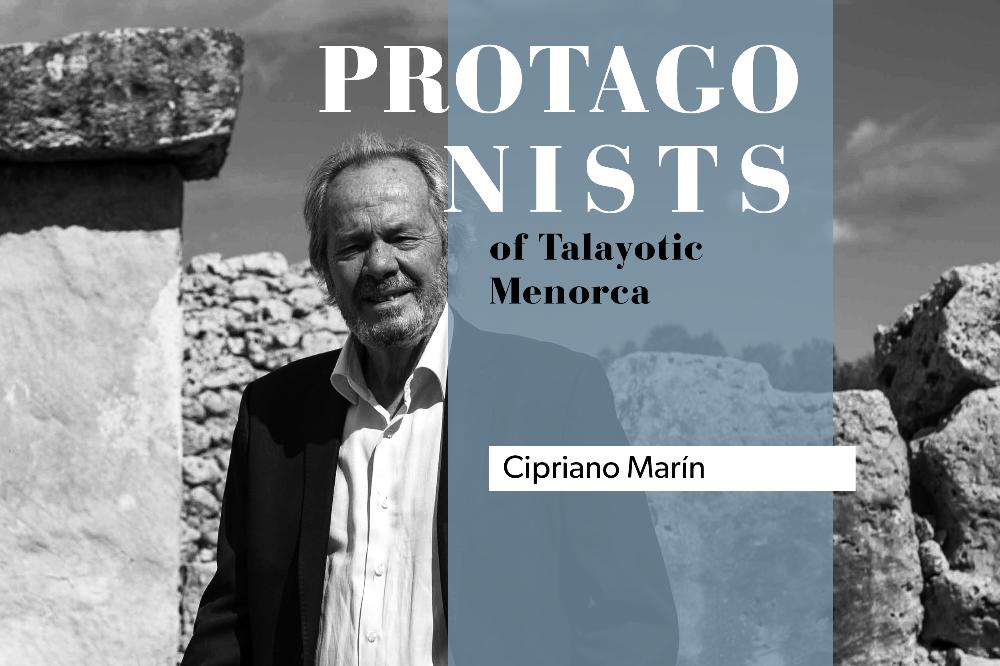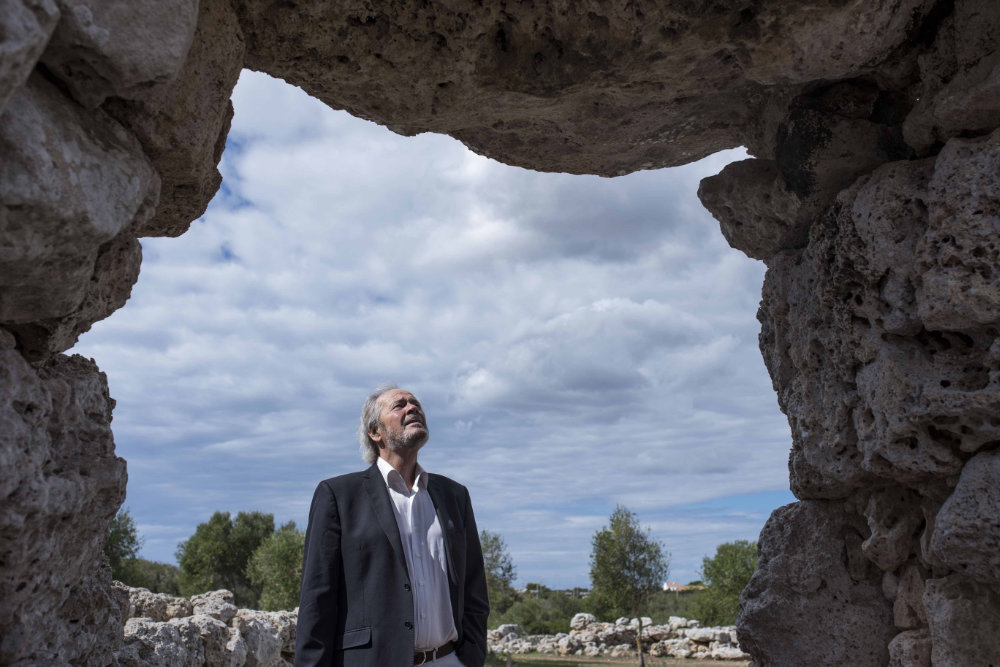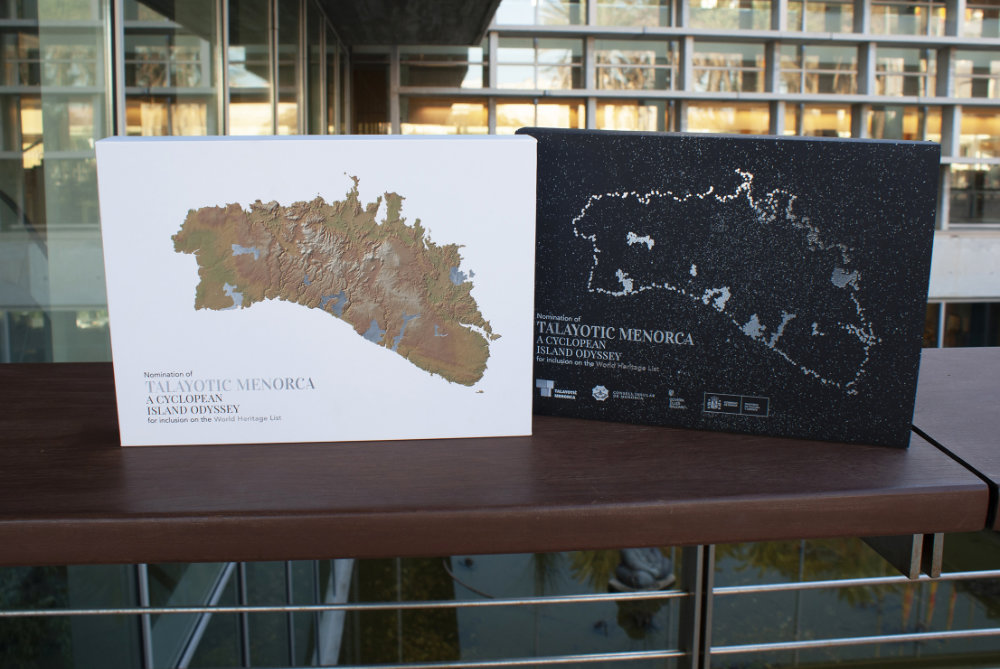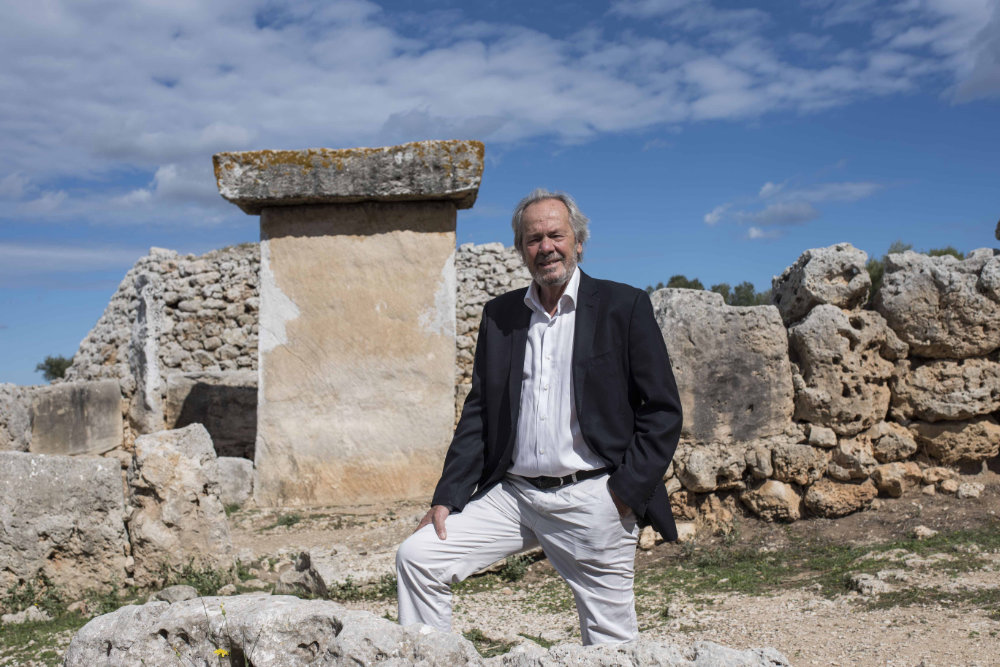 Cipriano Marín is one of the world's leading experts in sustainable island development. Coordinator of UNESCO programs such as Starlight, RENFORUS and Biosphere Smart, he has spearheaded numerous innovation projects related to sustainable tourism and ecology. Between 1992 and 2005 he was the head of INSULA (International Scientific Council for Island Development-UNESCO), part of the United Nations Educational, Scientific and Cultural Organization. His relationship with Menorca dates back to the declaration of the island as a Biosphere Reserve in 1993, which he was an integral part of. Now he is participating in the achievement of another historical milestone for the island, because since 2017 he has coordinated the new Talayotic Menorca nomination file as a UNESCO World Heritage Site.
Cipriano Marín is one of the world's leading experts in sustainable island development. Coordinator of UNESCO programs such as Starlight, RENFORUS and Biosphere Smart, he has spearheaded numerous innovation projects related to sustainable tourism and ecology. Between 1992 and 2005 he was the head of INSULA (International Scientific Council for Island Development-UNESCO), part of the United Nations Educational, Scientific and Cultural Organization. His relationship with Menorca dates back to the declaration of the island as a Biosphere Reserve in 1993, which he was an integral part of. Now he is participating in the achievement of another historical milestone for the island, because since 2017 he has coordinated the new Talayotic Menorca nomination file as a UNESCO World Heritage Site.
• You said once that an island is an island precisely because of its culture, that islanders have the idea of being on another universe. Is the Talayotic culture what makes Menorca an island?
This is true and it is not only me that says so. In 1992 the Earth Summit predicted that islands are very important for sustainable development, since they are home to an immense number of ecosystems and endemic species, as well as an extreme diversity of unique cultures. So we can understand that the nature-culture binomial is the pillar on which the foundations of insularity are built. In these terms, not all territories surrounded by sea should be considered as authentically insular. This would be the case of Japan, where a clearly insular culture has not been developed in its main islands, unlike on many of the 7,000 islands of its archipelago; or New Zealand, islands as large as Japan’s central ones, whose inhabitants consider themselves authentic islanders and are proud of their Maori roots.
Most of the islanders on the planet are extremely proud of their island and their local culture. However, usually we are not aware that we are part of a universe of more than 100,000 islands, inhabited by at least 500 million people. Therefore, in an increasingly dulled global world, it is essential to preserve the enormous joint force of island diversity, which includes natural and cultural diversity. And this has a lot to do with the global framework in which Menorca's candidacy is presented, understanding the Talayotic heritage as a representative and exceptional component of island cultures legacy.
With this vision, I think we can affirm that the ancient moais make Rapa Nui even more of an island in cultural terms, in the same way that the large naval base makes Guam less of an island in spite of it being isolated in the Pacific Ocean. Following this idea, the remains of the Talayotic culture, not only make Menorca more of an island but they are also a unifying element of its powerful cultural identity. We could define them as the glue of the island's history through the ages.
• “An insular cyclopean odyssey” is the motto of the new dossier for the Talayotic Menorca candidacy, why did you decide to give it such an epic touch?
Apart from the technical and scientific rigor required, nothing prevents the story of a candidacy from being vibrant and, at times, emotional or poetic. It should be emphasized that a candidacy’s file as a World Heritage Site is not only addressed to the experts from ICOMOS (International Council on Monuments and Sites) or the IUC (International Union for Conservation of Nature) who analyze and evaluate the proposal, but also is targeted to the entire international community. Therefore, we have decided to include expressions that also reach people’s soul and not just the experts on the subject.
About the motto "an insular cyclopean odyssey", I think it fits well with what we know about Talayotic culture. We are talking about a community that built a great number of cyclopean structures in a small Mediterranean island. But if we only reference the builiding of hundreds of talayots distributed throughout Menorca, there is no doubt that, for such a small human community with such little means, this was an incomparable colossal effort. It is not at all an exaggeration to speak about an odyssey of stone. I also think that it’s a true expression that pays tribute to those communities and reinforces the insular nature of the proposal.
• Since 2017 you’ve been coordinating the team that has reformulated the candidacy, has it been an odyssey to achieve it? How has it changed?
With regards to production time, I think it has been a real odyssey to get the current file completed within the deadlines that we had set. We must consider that nominations for World Heritage Site have become infinitely more complex and demanding in the last decade and candidacy preparations normally take longer than the time spent on this proposal. This would have been impossible without the tremendous collective effort of the great team that has participated in this reformulation and the determined leadership of the Consell Insular de Menorca at all levels. Permanent cooperation between the different administrations has been key, starting with the support of the Balearic Islands Government and the proactive role of the Spanish Ministry of Culture. When everyone is rowing in the same direction it is easier to achieve ones goals. It is also indisputable that having the foundations of the previous proposal has been an important advantage.
The most striking aspect of the new candidacy is that it is divided into nine territorial areas that include the best representations of cyclopean constructions and the exceptional landscapes associated with them, establishing a harmonic and symbiotic relationship. This candidacy also brings new elements in, such as the astronomical dimension of certain monuments and the vigorous relationship of the Talayotic culture with the sky. We reinforced the divergent cultural process lived on the island during Prehistory, which led to the creation of unique expressions comparing to its Balearic and Mediterranean peers.
Another aspect that has been underpinned is the comparative analysis. To be inscribed on the World Heritage List, an asset has to demonstrate not only its exceptionality and uniqueness, but also has to make the list more representative. In other words, the proposal serves to fill in gaps to complete the great cultural legacy of humanity. And this is demonstrated through comparative analysis with other registered or unregistered assets. In this sense, we have provided a convincing account of the expressions of this island culture within the framework of the Mediterranean and the islands of the world, recalling once again the scarce representation of the islands prehistory on the World Heritage List.
Finally, it should be noted that the new proposal has strengthened and presented a very detailed management plan, which parts from an exhaustive diagnosis of the asset’s state of conservation.
• In your opinion, what are the attributes that make this candidacy exceptional?
Well, the essence is the same as the one that supports our proposal of Outstanding Universal Value for Talayotic Menorca. Apart from some of the aspects that I’ve already mentioned, the first thing that stands out is the extreme quantity and density of prehistoric sites that have survived in Menorca. In adition to this, the diversity of expressions that are present: from funeraries, residences and defensive structures to hydraulic works and mining. And by the way, with an unprecedented level of protection compared to other territories, this is the BIC (Asset of Cultural Interest) island, as conseller Miquel Maria Ballester likes to say. This extreme density and diversity of vestiges of the past allows us to know in detail the evolution of this culture, and makes the proposed site an exceptional window into Prehistory, a truly open book where you can read into the past of an islands odyssey.
Secondly, the proposal defends that, despite their limited resources, those human communities were capable of creating exceptional and exclusive cyclopean works that are unique to this island, such as the funeral navetas, the monumental circular houses or the taula enclosures. Alongside the unique Menorcan talayots and the colossal effort involved in their construction, they constitute the main architectural attributes that convey the value of the property. In addition, we include the exceptional value of some of these monuments in the framework of cultural astronomy.
Thirdly, it must be considered that these monuments have marked the island's landscape during the last 3,000 years and have coexisted with generations of Menorcan people throughout its history. But the most significant thing is that they are inserted today in an extraordinarily well-preserved landscape that characterizes the traditional Menorcan agroecosystem. Displayed in this unique mosaic landscape is an incredible mesh of dry-stone wall that protects the vestiges of the past and maintains the spirit of the archaeological sites. The true highlight is that we’re dealing with a living and lived landscape, unlike most other archaeological sites. In comparative terms, we are dealing with one of the richest and most unique archaeological and monumental landscapes on the planet.
 A long distance race
A long distance race
• We are already half way through the race for the nomination. The file has been delivered to Paris, what awaits us now?
Although preparing the definite candidacy file has been the most complex and lengthy task, there is still a long way to go. The Ministry of Culture sent the final file to the UNESCO World Heritage Center in Paris at the end of January. From this moment on, the proposal is being analyzed by the ICOMOS Experts Panel and, eventually, by IUCN experts. During this analysis process, independent reports could be sought out and used.
The on-site assessment mission would take place during autumn of this year, with the Experts Panel first conclusions in hand. This mission’s goal is to verify the consistency of the proposal on the spot, as well as to analyze details, non-conformities and specific aspects of the file and also to gather supplementary information. Before the end of the year, ICOMOS will issue an interim report and will subsequently hold a meeting with those responsible for the candidacy at its headquarters in Paris. The final ICOMOS report will not be revealed until a month before the celebration of the World Heritage Committee, which is scheduled to be held in Kazan (Russia) between June and July 2022. Finally, the member states of the World Heritage Committee will take the ICOMOS recommendations into consideration and have their final word on the nomination during the session. In realitiy, the schedule will depend on the pandemic’s evolution. In fact, the 2020 Committee was unable to meet in China as was planned.
• Is the inclusion of Talayotic Menorca on the World Heritage List an end or a means?
I have always said that the objective of a nomination cannot and should not be exclusively to obtain an inscription on the UNESCO World Heritage List. As prestigious as this recognition is, it must be considered as one more mean in the process of safeguarding this exceptional legacy. The fundamental objective is to preserve Talayotic Menorca for present and future generations. It is more about assuming and acknowledging this responsibility than it is about earning a degree.
Whether or not the inscription is achieved, the important thing is that the registration process itself has laid the foundations of a solid and long-term strategy to preserve this common heritage. A strategy that is based on the recognition of Menorcans themselves as guarantors of their heritage, that will increase the value and perception that visitors have of it.
Simply put and setting the obvious differences aside, I would rather compare a nomination with the certificates of excellence that are so fashionable these days. The most significant thing about being a certified buisness or activity is not obtaining the label itself, rather it’s the constant improvement process that’s required to maintain it and to advance in providing excellent goods and services.
• How can a possible declaration as a World Heritage Site influence the sustainable development of the island?
I would like to recall that more than two decades ago, the declaration of Menorca as a Biosphere Reserve contemplated something new at that time. Menorca was not only the first island to bet on integrating the entire territory as a Biosphere Reserve, but also postulated that the island's cultural heritage, especially the prehistoric, constituted a key element for sustainable development. This idea was affirmed by Menorca before the 1992 Earth Summit who ultimately coined the term “sustainable development”. I remember perfectly how this caused great controversy in the UNESCO MaB Program, since at that time the term "sustainable development" refered exclusively to the environment and protected areas. If culture and heritage were mentioned, it was only referring to indigenous populations of remote territories. At that time, the environment was one thing and cultural heritage quite another.
For me, the eventual inscription of the Talayotic Menorca to the World Heritage List would be the icing on the cake of a pioneering concept of island and sustainability that was forged in the nineties. Menorca was twenty years ahead of UNESCO's current policy, which considers cultural heritage as a cornerstone of sustainable development, and which is also now contemplated in the United Nations Sustainable Development Goals.
That said, when talking about the impact of a World Heritage Site declaration on the development of a territory, the most frequent answer is to resort to the increase in tourism. But this is not exactly Menorca’s case. The island is and has been a consolidated tourist destination, and we all hope that it will continue to be so after the pandemic with a clear sustainable strategy. In this context, the enhancement of the Talayotic heritage and its eventual inscription on the list could strengthen cultural tourism and broaden the traditional turistic periods. All of them important factors in terms of the destination’s sustainability.
In any case, there is no doubt that if Talayotic Menorca were inscribed on the World Heritage List, it would be part of this exclusive club of UNESCO sites. The inscription would have a palpable effect on the positioning and image of the island at an international level in terms of sustainability and patrimonial responsibility. In today's world, this intangible value is extremely precious and would have repercussions in all areas of economic activity. Finally, we must not forget that both World Heritage Sites and UNESCO Biosphere Reserves are territories called upon to work in a network, which offers enormous possibilities for effective cooperation. In other words, it is about sharing to compete and position itself strategically, both in terms of sustainability and heritage conservation.